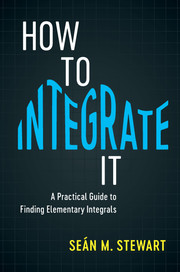Book contents
- Frontmatter
- Contents
- Preface
- 1 The Riemann Integral
- 2 Basic Properties of the Definite Integral: Part I
- 3 Some Basic Standard Forms
- 4 Basic Properties of the Definite Integral: Part II
- 5 Standard Forms
- 6 Integration by Substitution
- 7 Integration by Parts
- 8 Trigonometric Integrals
- 9 Hyperbolic Integrals
- 10 Trigonometric and Hyperbolic Substitutions
- 11 Integrating Rational Functions by Partial Fraction Decomposition
- 12 Six Useful Integrals
- 13 Inverse Hyperbolic Functions and Integrals Leading to Them
- 14 Tangent Half-Angle Substitution
- 15 Further Trigonometric Integrals
- 16 Further Properties for Definite Integrals
- 17 Integrating Inverse Functions
- 18 Reduction Formulae
- 19 Some Other Special Techniques and Substitutions
- 20 Improper Integrals
- 21 Two Important Improper Integrals
- Appendix A Partial Fractions
- Appendix B Answers to Selected Exercises
- Index
Preface
Published online by Cambridge University Press: 11 December 2017
- Frontmatter
- Contents
- Preface
- 1 The Riemann Integral
- 2 Basic Properties of the Definite Integral: Part I
- 3 Some Basic Standard Forms
- 4 Basic Properties of the Definite Integral: Part II
- 5 Standard Forms
- 6 Integration by Substitution
- 7 Integration by Parts
- 8 Trigonometric Integrals
- 9 Hyperbolic Integrals
- 10 Trigonometric and Hyperbolic Substitutions
- 11 Integrating Rational Functions by Partial Fraction Decomposition
- 12 Six Useful Integrals
- 13 Inverse Hyperbolic Functions and Integrals Leading to Them
- 14 Tangent Half-Angle Substitution
- 15 Further Trigonometric Integrals
- 16 Further Properties for Definite Integrals
- 17 Integrating Inverse Functions
- 18 Reduction Formulae
- 19 Some Other Special Techniques and Substitutions
- 20 Improper Integrals
- 21 Two Important Improper Integrals
- Appendix A Partial Fractions
- Appendix B Answers to Selected Exercises
- Index
Summary
Calculus occupies an important place in modern mathematics. At its heart it is the study of continuous change. It forms the foundation of mathematical analysis while the immense wealth of its ideas and usefulness of the tools to have emerged from its development make it capable of handling a wide variety of problems both within and outside of mathematics. Indeed, the sheer number of applications that the calculus finds means it continues to remain a central component for any serious study of mathematics for future mathematicians, scientists, and engineers alike.
The material presented in this volume deals with one of the major branches of calculus known as the integral calculus – the other being the differential, with the two being intimately bound. The integral calculus deals with the notion of an integral, its properties, and method of calculation. Our word for ‘integrate’ is derived from the Latin integratus meaning ‘to make whole’. As calculus deals with continuous change, integration, then, is a general method for finding the whole change when you know all the intermediate (infinitesimal) changes.
A precursor to the concept of an integral dates back to the ancient Greeks, to Eudoxus in the fourth century bce and Archimedes in the third century bce, and their work related to the method of exhaustion. The method of exhaustion was used to calculate areas of plane figures and volumes of solids based on approximating the object under consideration by exhaustively partitioning it into ever smaller pieces using the simplest possible planar figures or bodies, such as rectangles or cylinders. Summing its constituent parts together then gave the area or volume of the whole. Integration thus renders something whole by bringing together all its parts. Its modern development came much later. Starting in the late seventeenth century with the seminal work of Newton and Leibniz, it was carried forward in the eighteenth century by Euler and the Bernoulli brothers, Jacob and Johann, and in the nineteenth century most notably by Cauchy before the first rigorous treatment of the integral was given by Riemann during the middle part of that century. Since this time many other notions for the integral have emerged. In this text we focus exclusively on the first and perhaps simplest of these notions to emerge, that of the Riemann integral.
Information
- Type
- Chapter
- Information
- How to Integrate ItA Practical Guide to Finding Elementary Integrals, pp. vii - xiiPublisher: Cambridge University PressPrint publication year: 2017
